Cuteness often presents itself as helpless, pitiable, vulnerable and pathetic. By pulling on our heartstrings, cuteness encourages, even manipulates us into having tender feelings towards it. This ‘aww factor’ often renders the consumer as gooey-eyed as the object of affection and can sometimes tip over into aggression as the object’s ‘squeezability’ becomes overwhelming. Cuteness depends on an emotional response, and this response is greater when the power imbalance between the cute object and its consumer is dialled up. But who really holds the power?
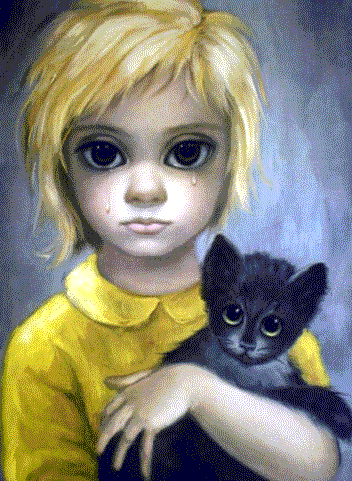
1
The Stray
1962
Margaret Keane
lithograph on paper
American artist Margaret Keane’s paintings of waifs and strays with big sad eyes, often with tears rolling down their cheeks and holding an equally sad-looking puppy or kitten, were enormously popular, particularly in the 1950s and 1960s where they graced cocktail lounges and suburban homes across America. However, for years it was Margaret Keane’s second husband, Walter Keane, who took credit for the paintings. A former real estate salesman, he had persuaded her to lock herself in her basement studio to paint for up to 16 hours a day, while he promoted her work as his own. By flooding the market with inexpensive reproductions on posters, plates and mugs he was able to enjoy both fame and fortune, with their products selling in the millions. But the ubiquity of the images, as well as their sentimentality, garnered criticism from the art critics who regarded the work as formulaic and tasteless. This scorn did little to dim the popularity of the work, with luminaries including Natalie Wood, Joan Crawford, Dean Martin, Jerry Lewis and Kim Novak buying the originals. Andy Warhol said at the time: ‘I think what Keane has done is just terrific. It has to be good. If it were bad, so many people wouldn’t like it.’ Margaret Keane herself said, ‘When people said it was just sentimental stuff it really hurt my feelings. Some people couldn’t stand to even look at them. I don’t know why – just a violent reaction.’ In 1970, now divorced from Walter, Margaret Keane revealed that she alone was responsible for the paintings and offered to prove it with a ‘paint-off’, challenging her former husband to a live demonstration of their respective painting skills. Walter didn’t turn up. In 1986, a second challenge in a court of law proved that Margaret was indeed the true creator of the paintings. Keane’s paintings fell out of favour until the 2014 biopic film Big Eyes by Tim Burton, himself a collector of her original paintings, revived interest in her work. Burton acknowledges the influence of Keane’s images on his own work.
words by Claire Catterall
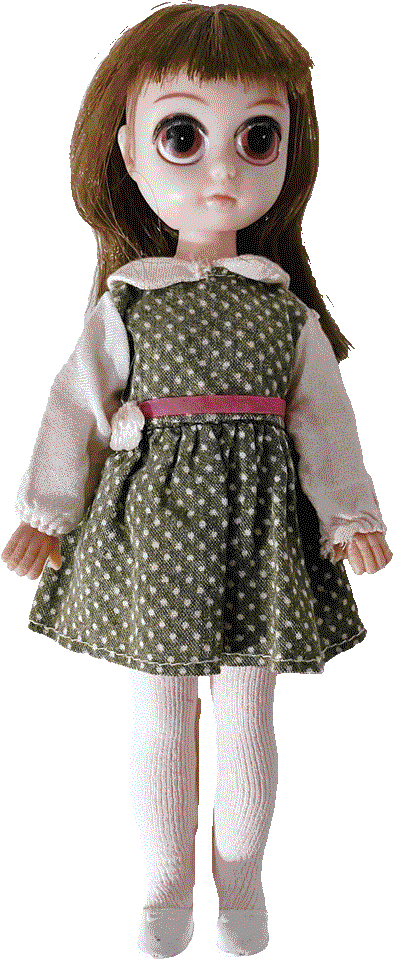
2
Susie Sad Eyes
1970
From The PolkAnok Collecton of Ania Goszczyńska and David Tibet
PVC dolls
At first glance, these plastic dolls are unassuming, standing around 8 inches high and sporting their cute outfits, but on closer inspection their crooked hairlines, oddly large eyes, and the grey, or even murky green, bags under their eyes, start to show. The dolls were inspired by the otherworldly big-eyed children painted by artist Margaret Keane. Their trademark ‘Sad Eyes’ speak to a common trope of cuteness: large, endearing eyes. Large eyes tread a fine line, slipping between cute and monstrous - just large enough for a Disney princess, but easily evoking a ghoulish Tim Burton style nightmare.
words by Vaishna Surjid
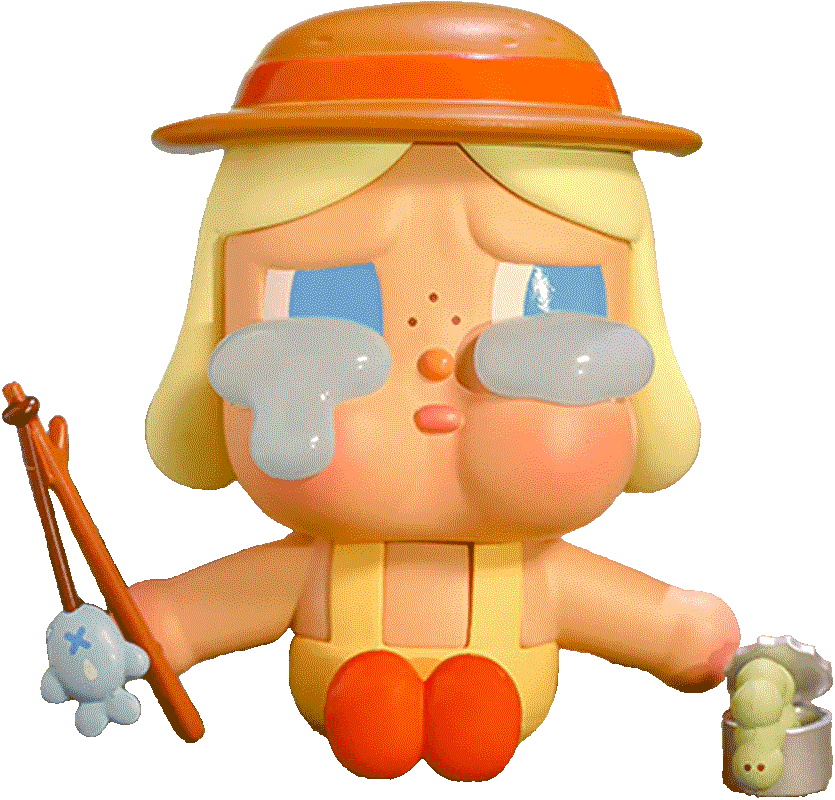
3
Crybaby Crying Parade series
2021
Courtesy Pop Mart
vinyl figures
Pop Mart and Thailand-based artist Molly Yllom of MOLLY’S FACTORY collaborated to create ‘Crying Parade’, the second series in Pop Mart’s CRYBABY line. This collection features cute, chubby-cheeked characters adorned in various parade costumes including a monkey and a drummer. Despite the conspicuous tears of all the figures, ‘Crying Parade’ revolves around the celebration of emotions, hence the parade, echoing the sentiment expressed in Lesley Gore’s lyrics, ‘It’s my party, and I’ll cry if I want to’. Founded in 2010 by Wang Ning, Pop Mart has risen to prominence as a Chinese toy company specializing in the sale of collectible designer toys, often packaged in a blind box format. This unique packaging conceals the identity of the collectible toy until the moment of unboxing. The company’s success has flourished, resulting in the establishment of more than 288 outlets and 1800 vending machines, aptly named ‘roboshops’. Marketed towards youth culture in China, Pop Mart’s blind boxes have earned a reputation for being ‘addictive’, according to Chinese media. This addictiveness is fuelled by the mystery and anticipation surrounding the contents of each blind box, prompting consumers to make repeated purchases in the pursuit of securing their desired figures or completing entire collections. This heightened demand has resulted in increased regulations in China and beyond, dictating who is permitted to purchase these toys. Pop Mart has worked with renowned designers and artists, such as Keith Haring and SKULLPANDA, to develop its toys.
words by Ailinn Santos

4
HACIPUPU In My Dream series
2022
Courtesy Pop Mart
Vinyl figures
Launched by Pop Mart in 2023 and designed by the creative design duo Agee & Yep, the HACIPUPU In My Dream series transports collectors into a whimsical realm inspired by the vivid imagination of children. These figures showcase Hacipupu, a character embodying cuteness and innocence, serving as a reminder to protect the childlike wonder within each of us. Despite carrying a melancholic, puppy-like expression, Hacipupu engages in playing dress-up throughout the series, donning charming costumes that include a cactus, a honey pot, and even a prince. The allure of the In My Dream series lies in the element of surprise, as collectors can acquire Hacipupu figures through the purchase of blind boxes. Comprising a total of 13 distinct figures, some are intentionally made rarer than others, often referred to as ‘secret’, ‘hidden’, or ‘chase’ figures, contributing an extra layer of excitement to the collecting experience. The rarest find in the collection is Hacipupu dressed as a semi-translucent candle, clutching a matchstick, with the probability of encountering this elusive figure at 1 out of 144 boxes. With each blind box holding the promise of a unique and charming Hacipupu, collectors are invited to delve into the enchanting world of these figures, each one representing a delightful facet of youthful imagination. The question remains: which endearing version of Hacipupu do you want to find?
words by Ailinn Santos

5
XXL Rainbow Eemo Cloud and Self-Supporting
2023
Jessica Emmett
Vinyl figures
Rainbow Eemo Cloud and Self-Supporting are two designer toys by Jessica Emmett, a Singapore-based illustrator and toy designer. During the COVID-19 pandemic, Emmett found herself constantly fatigued and unmotivated, with only intermittent spurts of energy. This enforced sense of self-reflection inspired her to create Eemo Cloud, a depressed but hopeful raincloud, dipping into the mental health awareness discourse surrounding the pandemic that became increasingly prevalent. Self-Supporting, a wounded bunny using its ears to stand, is the artist’s response to her knee surgery, which has permanently affected her mobility. Its complex smile mirrors Emmett’s sad but forward-looking outlook. While there is an empathy-inducing prompt urging one to give the characters (and by extension Emmett) a warm, soothing hug, both projects are self-assertive and empowering. They exemplify cuteness’s ability to alter the emotional dynamic between the powerless and the powerful when dealing with threats and trauma.
words by William Seung
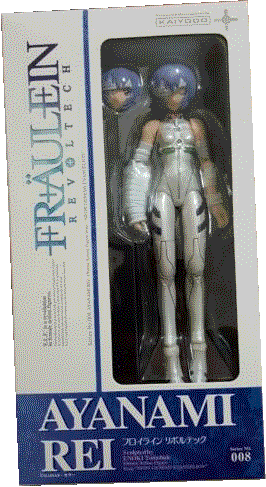
6
Fraulein Revoltech 008 Rei Ayanami Bandage Version
2008
KAIYODO
Action figure
Rei Ayanami is a female protagonist from the Japanese media franchise Neon Genesis Evangelion, created by Hideaki Anno with the first animated TV episode broadcast in 1995. Ayanami is known for her quiet stoicism, frequently suffering injury from battling with monstrous beings called Angels. As a clone of the male protagonist’s mother, she has no childhood and considers herself expendable. Her mysterious and pitiful character arc has generated a cult-like following, mostly consisting of men. Moreover, merchandise featuring Ayanami’s character always topped the charts, with the most popular being the action figure covered in bandages. Ayanami’s popularity gave rise to a new archetype of animated female characters, characterised by their young age, emotionless expressions, troubled backstories and injuries or illnesses. The increasing prevalence of non-vocal injured girls within this genre highlights how our affections are tightly linked to the vulnerable, with an element of fetishisation at work.
words by William Seung
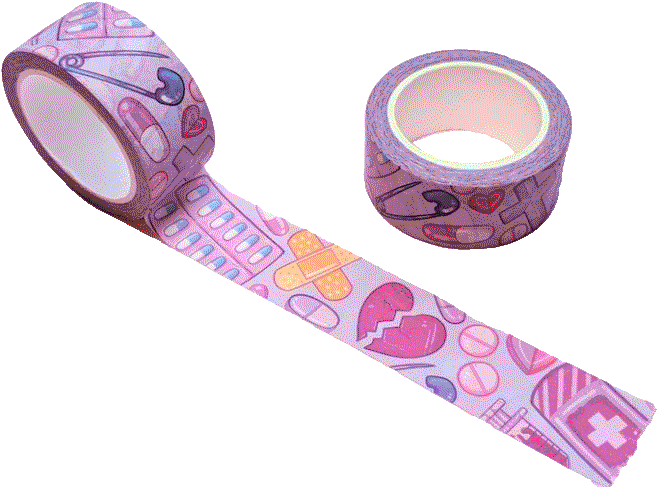
7
Yami Kawaii
2023
Various artists
Fashion accessories
Yami kawaii, or ‘sickly cute’, is an international movement and safe space for young people to explore issues of mental health. Originally emerging from Japan’s ‘menhera’ kawaii movement, it gained traction with international practitioners overseas on platforms like Tumblr and Instagram, flourishing through illustration, fashion and product design. Using imagery of both tools of healing and harm, yami kawaii is known for its ‘vent art’ as an expression of desperation and despair. The juxtaposition of both sweetness and violence reverberates to create an aggressively cute form of expression. Here on display we have a variety of characters and decorative supplies characteristic to yami kawaii, created by Eternalbattoru, KawaiiRebelsShop, Chaoillustrations and ScribbleBunnyArt. While the bandaid stickers are typically applied to the face of practitioners as part of their makeup, the roll of ‘deco tape’ is a play on kawaii stationary and can be used for journaling and letter writing to friends. Girl-figures appear as avatars for the practitioners (who are of all ages and genders), as nurses nursing their own injuries, which are metaphorical for emotional wounds. During the 2000s on Japanese anonymous boards online, users began to discuss issues of mental health, and from here emerged the ‘menhera’ (mental health) movement. Menhera kids sought to reclaim the heavy stigma attached to mental issues in Japan, and from this community emerged characters such as Menhera-chan by Bizuko Ezakai. Today, yami kawaii can be seen in places like Harajuku, mixing both cute and dark elements as an expression of both resistance and brokenness. Internationally, fans congregate online in a community that is now significantly larger than their Japanese counterparts, with its own meaning and values. While there is ongoing discourse about the degree to which yami kawaii art might romanticise issues of self-harm, many practitioners report how crucial and lifesaving it has been to have a community and safe place to speak frankly about their mental health.
words by Dr Megan Catherine Rose

8
LARME Magazine, Issue 56, 17 March 2023
2023
LARME
Magazine
LARME is a Japanese fashion magazine aimed at young women, known for its soft, dreamy and gentle aesthetic. Founded in 2012, LARME features a range of kawaii fashion for women aged 18 to 25, from flirtatious retro pin-up though to ‘a-sexual’, princessy lolita fashion dresses. ‘Larme’ translates to ‘tear’ and was chosen by the magazines founder Haruna Nakagori to express the tearful, sad and resilient kawaii aesthetics expressed in its pages. Indeed, LARME is best known for popularlising the ‘yami’ (crying; sickly) makeup featured on the cover of this issue, which is created through shimmering pink pigments placed under the wearer's waterline. The cute imagery in LARME creates a heartfelt universe for girls by girls, that is both a knowing cheeky wink and performance of solidarity and resilience. By pushing hyper-femininity to extreme ends, its aesthetics create a liminal space for its readers that repels the darkness. For Nakagori, the world she created through LARME has always been shadowed by feelings of sadness and trauma that many young women in Japan experience. In its pages, she specifically wanted to create a place free of men, plush toys appearing as softer, playful alternatives to heartbreak, abuse and the looming threat of violence. Toys become tools of disruption and resistance for young women, referencing both a pursuit of softness and the precarity that the world brings.
words by Dr Megan Catherine Rose

9
Sad Sam
1980
Applause
Toy dog
Created in 1980, Sad Sam and friends, including his girlfriend Honey, were a collection of toy plush animals with huge pleading eyes on the brink of tears. Originally manufactured by Applause in the US, Sad Sam’s success was in part a result of its emotive appeal to its child consumer feeling compelled to ‘rescue’ and take care of him, his foreshortened limbs adding to a cute iconography that triggers maternal feelings. This dynamic is central to cuteness’s function in consumer capitalism. As the scholar Daniel Harris argues in Cute, Quaint, Hungry and Romantic: The Aesthetics of Consumerism, ‘Because it generates enticing images … of ugliness and dejection, cuteness has become essential to the marketplace, in that advertisers have learned that consumers will “adopt” products that create, often in their packaging alone, an aura of motherlessness, ostracism, and melancholy, the silent desperation of the lost puppy dog clamouring to be befriended – namely, to be bought.’ Arguably, Sad Sam toys are as popular now as in their 1980s and 1990s heyday, with adults searching for toys on internet resale marketplaces such has eBay, in an attempt to rekindle the emotional connections and loyalties felt so strongly in their youth. The act of bidding on eBay only adds to the compulsion and sense of ‘rescue’. These ‘vintage collectibles’ demonstrate how nostalgia is mobilised to encourage us to retrieve our past through competitive consumption.
words by Claire Catterall
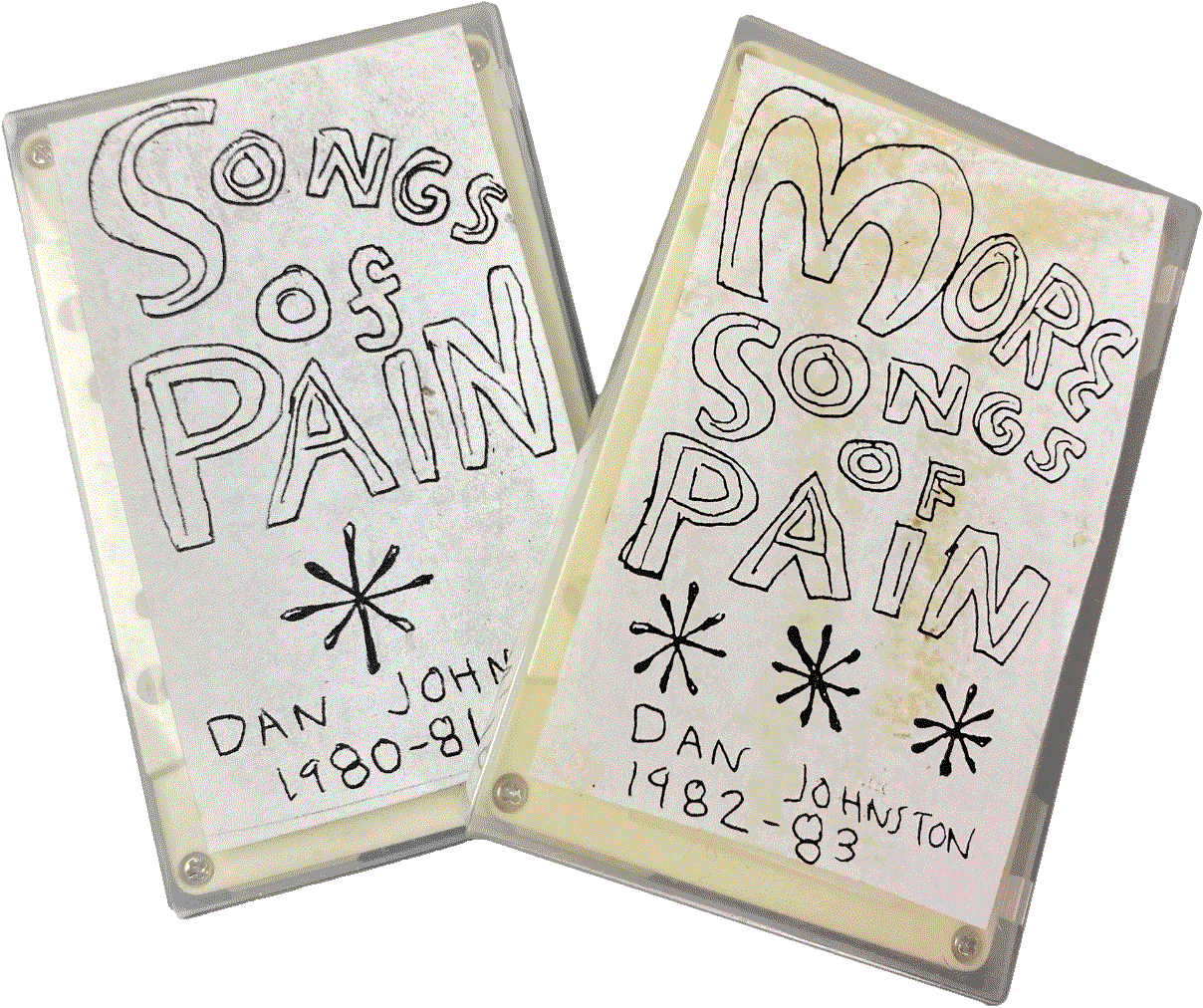
10
Songs of Pain, More Songs of Pain, Don’t Be Scared
1980
Daniel Johnston
Cassettes
Daniel Johnston was an artist, singer and musician known for his childlike approach to his work, which focussed on themes of love, loss and longing. He painted and drew adorable imaginary creatures and sang about love with unguarded emotion. After moving from Sacramento to Austin during his early 20s in the 1980s, he began distributing his music by giving out tapes with rudimentary hand-drawn covers to customers at his fast food service job. He became a local hero in Austin, but his life and career were marked by struggles with mental illness and a difficult relationship with fame. He was the quintessential too-pure-for-this-world character. The human-animal-alien hybrids he drew and the lyrics he wrote often suggested the possibility of a simpler life, untouched by the pressurising forces of the music industry and art world. For example, in the title track of ‘Don't Be Scared’ he sings ‘There's a life worth living and it's interesting / There's a calm that's real somewhere / There's a jungle stream and band that's playing / There's a tune worth whistling to / Don't be scared’.
words by Phin Jennings
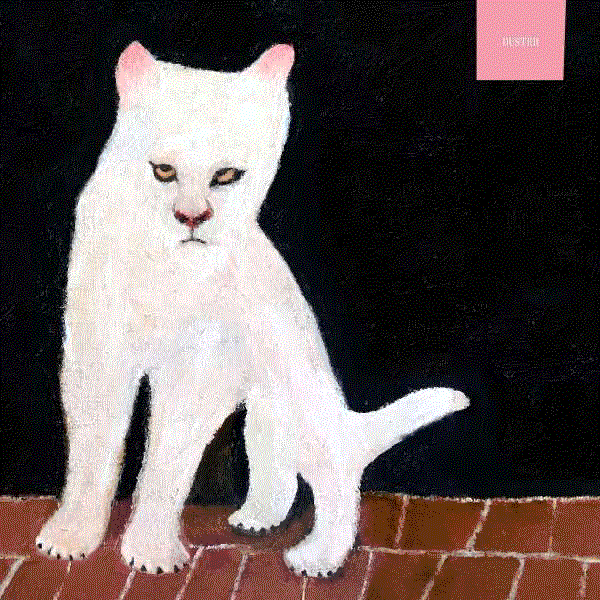
11
Duster
2019
Phin Jennings
Vinyl record
Formed as a three-piece band during the mid-1990s in San Jose, Duster's music is generally described as slowcore: a rock subgenre defined by trudging tempos, subdued instrumental performances and emotional lyrics. In the wake of hardcore punk, whose supercharged, heavy sounds electrified the 1980s, Duster made music to yearn to. Since the reissue of their breakthrough album Stratosphere, more than 20 years after its initial release in 1998, the band have found success with a large audience, most of whom won't remember its original launch. Some of their songs have been popular on Tik Tok, featuring in videos that play up to their sad, eerie aesthetic. Their self-titled album, released in 2019, has become another slowcore classic with songs titled ‘I'm Lost, Damaged’ and ‘Hoya Paranoia’. The cover of the album is taken from a painting Salvatore Olentino, a self-taught Italian artist who moved to Brooklyn in 1960. It depicts a glum-faced, soft-pawed white cat, an image that brings Duster’s cute side into focus: the music, like the cat, is not angry but sad and vulnerable. It resonates today, as it did in the 1990s, with the softer side of its listeners. On its release, The Wall Street Journal's Mark Richardson commented that the songs on this record ‘don't describe isolation and alienation, they embody it.’
words by Phin Jennings

12
Sad Boys bucket hat
2023
Dope Premium
Bucket hat
At the age of 16 Jonatan Aron Leandoer Håstad, better known as rapper Yung Lean, formed the rap group ‘Sad Boys’ with friends from his hometown of Stockholm in 2012. Their musical style was spaced out and soft, their lyrics emotional and vulnerable and their style unintimidating. Leandoer often dyes his hair pastel colours and wears cute, colourful outfits; his videos laced with retro net graphics, Pokémon cards and Nintendo avatars. He has also recently dropped a range of plushies. His music became popular on online platforms including Tumblr and Soundcloud, making him an early example of ‘Soundcloud Rap’. The internet-native genre has expanded into the mainstream in the last ten years, with household names identifying with it. Artists like Yung Lean and Sad Boys arguably paved the way for similar rappers with a similarly emotional, soft-edged style such as Lil Uzi Vert, whose song ‘XO Tour Llif3’ - featuring the lyrics ‘Push me to the edge / All my friends are dead’ - was streamed 1.3 billion times during the summer of its release.
words by Phin Jennings
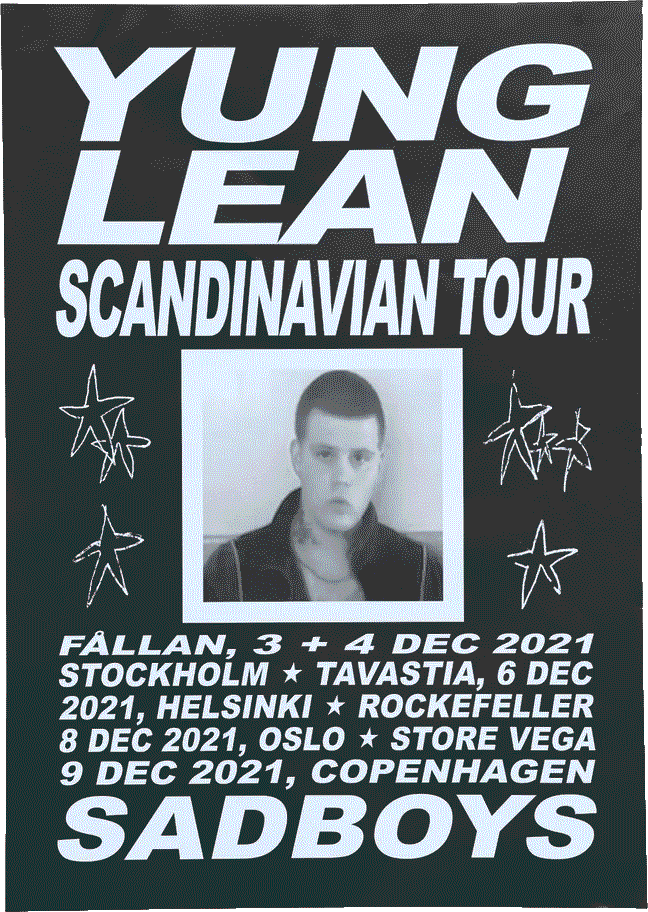
13
Scandinavian tour poster
2021
Yung Lean
Poster
At the age of 16 Jonatan Aron Leandoer Håstad, better known as rapper Yung Lean, formed the rap group ‘Sad Boys’ with friends from his hometown of Stockholm in 2012. Their musical style was spaced out and soft, their lyrics emotional and vulnerable and their style unintimidating. Leandoer often dyes his hair pastel colours and wears cute, colourful outfits; his videos laced with retro net graphics, Pokémon cards and Nintendo avatars. He has also recently dropped a range of plushies. His music became popular on online platforms including Tumblr and Soundcloud, making him an early example of ‘Soundcloud Rap’. The internet-native genre has expanded into the mainstream in the last ten years, with household names identifying with it. Artists like Yung Lean and Sad Boys arguably paved the way for similar rappers with a similarly emotional, soft-edged style such as Lil Uzi Vert, whose song ‘XO Tour Llif3’ - featuring the lyrics ‘Push me to the edge / All my friends are dead’ - was streamed 1.3 billion times during the summer of its release.
words by Phin Jennings